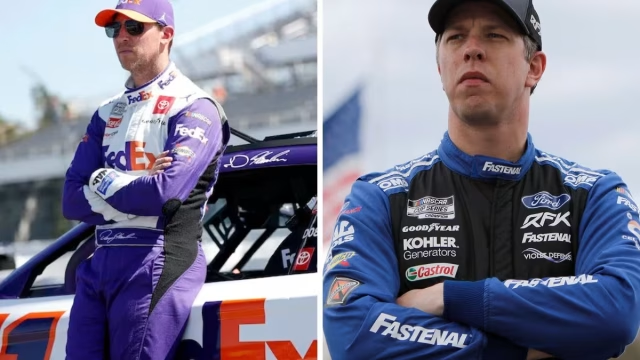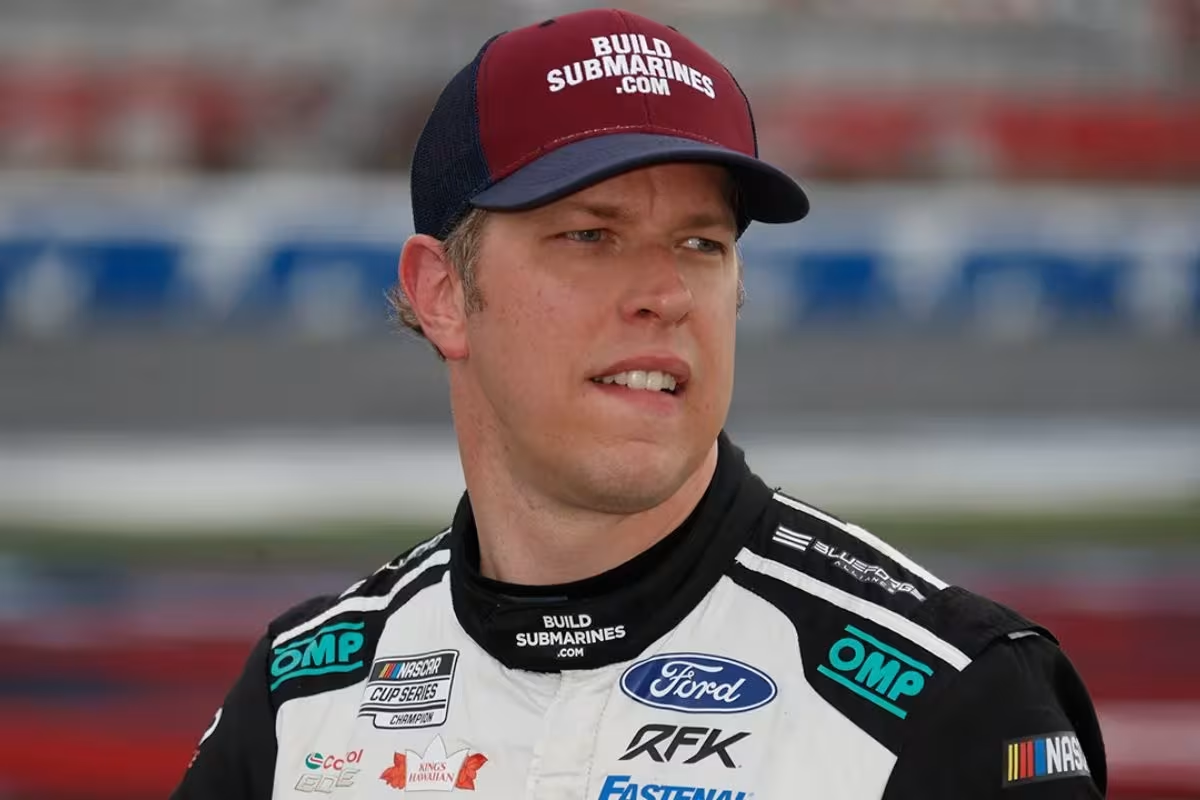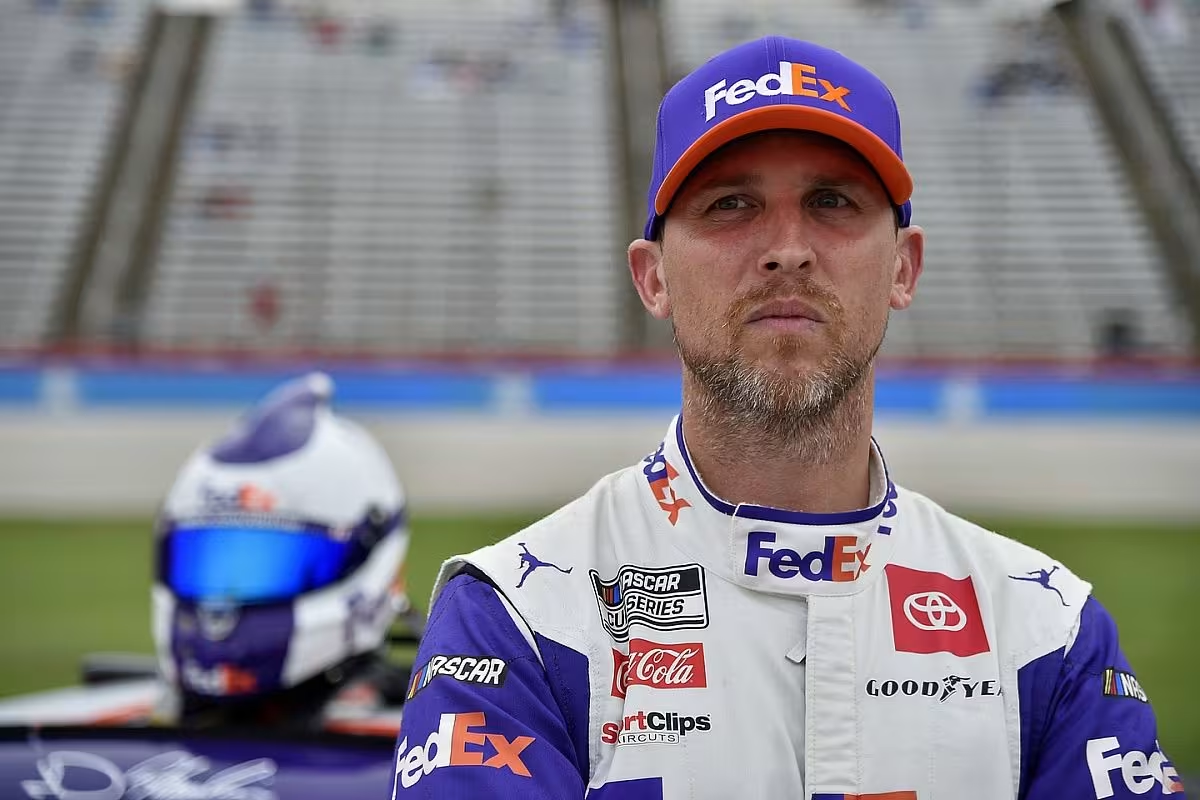Denny Hamlin Gets Mocked: Denny Hamlin is currently in drama within the NASCAR community, facing derision from an insider connected to Brad Keselowski. The stems from Hamlin’s vocal advocacy for increased horsepower, a move he believes is crucial for enhancing race competitiveness. This debate reflects broader concerns surrounding NASCAR’s current performance dynamics, particularly following a Bristol race with few lead changes. While Hamlin argues that current aerodynamic packages fall short remains among team owners, including RFK Racing, about the efficacy of proposed adjustments. The unfolding tensions highlight an evolving narrative that impacts both racing strategy and fan engagement. Further developments are anticipated.
Key Highlights
- Denny Hamlin’s push for increased horsepower faced, shows by Brad Keselowski’s insider mocking his stance amidst ongoing NASCAR discussions.
- Keselowski’s performance at Bristol raised questions about the effectiveness of proposed horsepower changes race competitiveness.
- RFK Racing, including Keselowski, expressed concerns about whether horsepower improvements would truly address core racing issues.
- Hamlin emphasized the necessity of higher horsepower for better racing dynamics, which has sparked debate among drivers and team owners.
- The recent interactions reflect broader tensions in NASCAR regarding performance regulations, safety, and the need for competitive balance.
NASCAR Playoffs: Bristol as the Eliminator
The NASCAR playoffs are known for their intensity and unpredictability, but the recent race at Bristol displayed a clear contrast to these expectations. Unlike the anticipated competition, the race unfolded as a rather subdued affair, raising big questions about the current state of short-track racing in the series.
With only eight lead changes compared to the exhilarating 54 in the spring race, it became evident that Bristol’s layout and the performance of the next-gen cars did not foster the competitive spirit that fans and drivers had hoped for.
Kyle Larson’s dominant performance, leading an astounding 462 laps, shows the challenges presented by the high tire durability. The lack of notable tire fall-off, which had previously resulted in dramatic tactical battles, rendered passing nearly impossible.
This scenario has ignited debates surrounding the effectiveness of NASCAR’s short-track package, revealing a reevaluation of both the tire constructions from Goodyear and the inherent design of the next-gen car.
Denny Hamlin, an outspoken advocate for reform, has stressed the need for increased horsepower to competition on short tracks. His fourth-place finish at Bristol further validated his concerns, indicating that the current conditions may inhibit true racing skill.
As discussions about potential changes continue, the Bristol race serves as a vital case study, showing the delicate balance between car design, tire performance, and the essence of competitive racing in NASCAR.
RFK Racing Joins in the Horsepower Debate
As discussions surrounding the need for increased horsepower in NASCAR gain momentum, RFK Racing has emerged as a prominent voice in this debate. The team’s performance and competitive strategy have positioned them at the forefront of the conversation regarding the 670 horsepower limit imposed for the 2024 season.
“The more you can get us out of the gas, which means if we have more horsepower, we have to let off sooner, that gives us the opportunity to overtake for the cars behind. Fifty horsepower, while it may not be a game changer, any horsepower gain will be an advantage for passing.”-(hamlin)
Denny Hamlin’s advocacy for a return to the 750 horsepower configuration highlights an essential aspect of racing dynamics: the balance between speed and overtaking opportunity. Hamlin argues that improved horsepower not only increases speed but also requires drivers to manage throttle input more judiciously. This, in turn, fosters a racing environment where overtaking becomes feasible, thereby elevating the entire excitement of the competition.
RFK Racing’s perspective aligns well with this sentiment; the team recognizes that while aerodynamic modifications can improve handling, the fundamental essence of racing still hinges on the raw power of the vehicles.
The recent changes to the aerodynamic package, including the wider spoiler and modified diffuser, may increase downforce but do little to address the concerns voiced by drivers regarding passing opportunities.
RFK Racing’s engagement in this discourse emphasizes their commitment to optimizing competitive balance and ensuring that their drivers can effectively challenge one another on the track. As the debate unfolds, the implications of horsepower limits on racing strategy and fan engagement remain significant, and RFK Racing’s involvement will certainly shape the evolution of NASCAR’s competitive landscape.
Skepticism from RFK Racing
Amid the fervent discussions on horsepower improvements, skepticism has emerged from within RFK Racing, particularly highlighted by comments from quality control specialist Brian Murphy. His recent statement on X emphasizes a growing concern that simply adding horsepower may not address the underlying issues plaguing the current NASCAR landscape.
Murphy articulated a sense of disillusionment, stating, “I’m beyond ecstatic for if/when we add 250HP to this platform and everyone is still disappointed…” This sentiment reverberates through the RFK ranks, especially following Brad Keselowski’s performance at Bristol, where he started 23rd and finished in 26th place.
I’m beyond ecstatic for if/when we add 250HP to this platform and everyone is still disappointed….
— Brian Murphy (@Brian_Murphy_) September 26, 2024
Keselowski’s post-race analysis further amplifies his observation that the race lacked pace and that tires did not exhibit the expected wear raises questions about the efficacy of proposed horsepower improvements. It suggests that the core challenges facing NASCAR may extend beyond mere numbers on a dyno.
“Just didn’t have any pace. No attrition for the race, tires didn’t fall off and we didn’t have the pace.”-(keselowski)
The lack of attrition and competitive racing dynamics point to a more systemic issue, potentially rooted in chassis design and track conditions, rather than horsepower alone.
RFK Racing’s reflects a broader unease within the industry. The call for increased horsepower, while well-intentioned, may not suffice to rejuvenate the racing experience or restore fan enthusiasm.
As the debate continues, it will be essential for NASCAR to reflect on these insights seriously, ensuring that any changes made are holistic and targeted towards improving the complete racing product.
Hamlin’s Perspective on Necessary Changes
Drawing from nearly two decades of experience in NASCAR, Denny Hamlin presents a compelling case for the necessity of increased horsepower as a catalyst for meaningful change within the sport. His assertions are grounded in a thorough understanding of the intricacies of racing dynamics, where he highlights that merely tinkering with aerodynamics is insufficient to achieve the desired competitive balance.
Hamlin argues that the current aerodynamic package introduced in 2024 will yield little to no improvement unless accompanied by substantial changes in horsepower.
Hamlin articulates this perspective with clarity, stating, “Until you make a horsepower, or tire, or shifting change, you will have the same result.” His observations from tracks like Martinsville highlight a crucial issue: the horsepower-to-tire ratio is a fundamental determinant of performance, especially in cornering scenarios where cars are observed losing speed. This sentiment belief that NASCAR’s to adopt increased horsepower may be a barrier to progress.
“Until you make a horsepower, or tire, or shifting change, you will have the same result. You’re right. We keep tinkering with aerodynamics. I’m sorry, we’re running 45 miles per hour in the middle [of the corners] at Martinsville. It’s not aerodynamics. It’s a horsepower-to-tire ratio, and until we get that through our thick skulls, it will remain the same. But it will have to come from the high-ups at NASCAR to say, ‘Fine, we’re done. We’ve seen parity, and we don’t like it.”-(hamlin)
Furthermore, Hamlin’s stance reflects a broader frustration within the racing community regarding the concept of parity. He intimates that for NASCAR to evolve and improve the spectacle of racing, it must recognize that the current approach may not resonate with the fans or the drivers similarly.
Hamlin’s insights shows a crucial conversation about the future of the sport, suggesting that without substantive changes, the status quo will persist, ultimately stifling the excitement and competitiveness that define NASCAR.
NASCAR’s Concerns and Hamlin’s Rebuttal
NASCAR finds itself at a crossroads, steering the delicate balance between improving entertainment value and ensuring driver safety. The debate surrounding increased horsepower has ignited a discussion that transcends mere performance metrics. With notable voices within the organization, such as Chief Operating Officer Steve O’Donnell and Chief Racing Development Officer John Probst, expressing concerns about the fiscal and logistical implications of such changes, the complexities become evident.
“Until you make a horsepower, or tire, or shifting change, you will have the same result. You’re right. We keep tinkering with aerodynamics. I’m sorry, we’re running 45 miles per hour in the middle [of the corners] at Martinsville. It’s not aerodynamics. It’s a horsepower-to-tire ratio, and until we get that through our thick skulls, it will remain the same. But it will have to come from the high-ups at NASCAR to say, ‘Fine, we’re done. We’ve seen parity, and we don’t like it.”-(Steve O’Donnell)
Hamlin, a sad figure and owner of the 23XI racing team, challenges the notion that increased costs are an inevitable consequence of raising horsepower. He argues that reverting to the previous 750 plate can be executed swiftly and economically, emphasizing that the change can be implemented with a simple phone call to engine managers. This perspective shows a potential disconnect between the organization’s leadership and the operational realities faced by team owners.
“If you add the horsepower, you add the cost, then you see if it is better. There’s no guarantee you get there, and it would be any better. And I think there’s some evidence that shows as we add horsepower, they run further apart”.-(John Probst)
While NASCAR covers with these many issues, the voices of its drivers and team owners, like Hamlin, will be critical in shaping the future direction of the sport. The ongoing dialogue reflects not just the immediate concerns of safety and performance, but also the foundational principles that govern NASCAR’s evolution.
News in Brief: Denny Hamlin Gets Mocked
ALSO READ: Denny Hamlin’s Playoff Future Looks Grim: Experts Share Their Concerns



